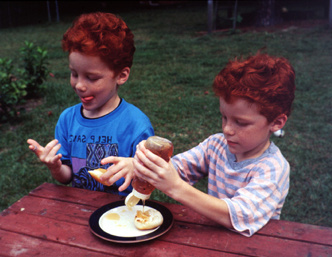
What Bees Eat

Grades: K-3
Essential Skills: Science, Visual Arts, Drama
Duration: 1 class period
OVERVIEW
Students are introduced to the concept that plants and animals are dependent on one another and that bees visiting flowers are busy gathering food.
Preparation
Curriculum Support Materials:
Information Sheets:
Lesson Plan
Introduction Activity ( 30 minutes)
Discuss the parts of the flower. Dissect a fresh flower and show the reproductive parts. Explain that the pollen comes from the anthers and moves to the stigma during pollination. Sometimes a plant can pollinate itself, but many plants require assistance of wind, insects, birds or bats to move pollen from flower to flower.
For example, saguaro flowers open only at night and are pollinated largely by bats, although white-winged doves visit those flowers remaining open in the early morning.
Activity 2 Making flowers (30 minutes)
Simple flowers may be made by layering three or four facial tissues on top of one another. Trim the ends, or scallop with scissors. Gather at the center and tie with a pipe cleaner. Fluff into shape. Or use colored tissue paper. Tulips can be made using paper cups and pipecleaners.
Grades 2-3 may collect actual flowers or make more realistic flowers from other materials.
Activity 3 Finding flowers (30 minutes)
Give each student a paper cup. If the students are still grouped into bee colonies (from Lesson 1.2), hide some of the flowers. Have a few bees from each colony search for the flowers. When they succeed in finding one, give them some water or juice in their cups as a nectar substitute. Have the first bees go back to the colony and tell the others where they found the flowers and nectar. Then other bees can go to the flower, until all of the children have cups of nectar. The bees could also relay the nectar back to the hive to store in cells (cups).
Add pollen by giving each student a cotton ball to serve as a pollen basket and then roll the ball in glitter or whole wheat flour.
AHB Note: Africanized honey bees are thought to gather more pollen than other honey bees and
use it to raise more larvae for rapid reproduction. European bees came from a colder climate and
collect more nectar to store as honey for survival over the winter.
Activity 3 Pollination game (30 minutes)
Have some students act as honey bees and some can be flowers. Have the flowers try to be attractive to bees. Students have to decide what aspects of flowers might make them attractive to bees, such as size, shape, odor, color, amount of nectar, etc.
Students may want to make flowers from various materials available in the classroom. When the bees decide the flowers are attractive to bees, have them approach and pollinate the flowers with the glitter that is on the cotton balls.
Conclusion Honey bees give us food (30 minutes)
Show Poster 7 (Products of the hive) and discuss the items depicted, such as honey and beeswax.
Bring in honey from different sources to show the different colors honey can be. Honey can range in color from as dark as molasses to as light as cooking oil. Save the honey for the conclusion of Lesson 1.4.
Ask how many students have honey at home and how they use it. Have the students ask their parents for honey recipes, or for foods made with honey.
Discuss how farmers rely on beekeepers to bring honey bees to their fields when their crops are flowering so that they are assured of good pollination for fruits and vegetables. Display fruits and vegetables that require honey bees for pollination, such as watermelons, apples, citrus, cucumbers and almonds.
Additions
Extensions:
Words with special meanings:
(for understanding only, not to be tested)
Bibliography:
The Secret Life of Flowers, by Anne Ophelia Dowden. Published by The Odessey Press, N.Y., 1964.
The Clover and The Bee: A Book of Pollination, by Anne Ophelia Dowden. Published by Harpers
Collins Publishers, N.Y., 1964.
Roses Red, Violets Blue: Why Flowers Have Colors, by S. A. Johnson and Y. Sato. Published by Lerner, M.N., 1991.
The Pollination of Flowers, by Michael Proctor and Peter Yeo. Published by Collins, London, 1973.